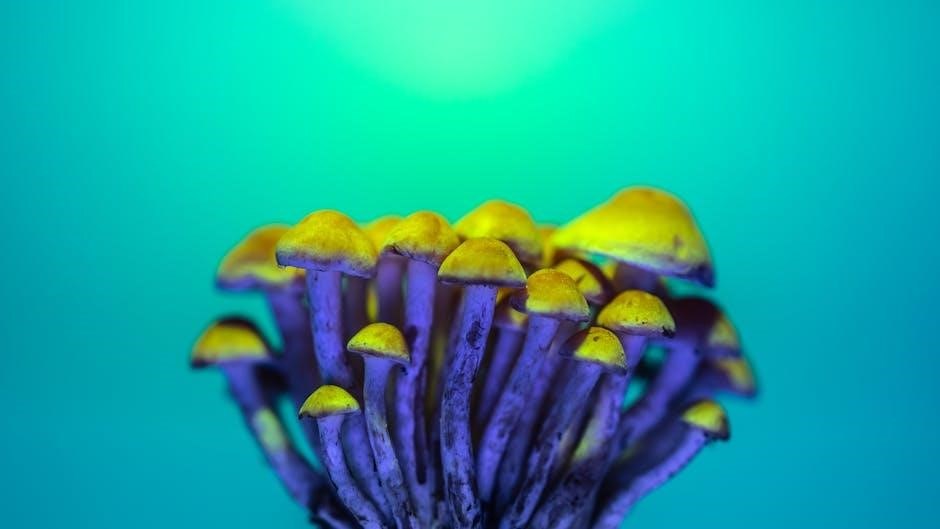Psilocybin magic mushrooms are fungi containing the psychoactive compound psilocybin, known for their profound effects on perception and consciousness. Native to various regions, they have been used in traditional rituals and modern research, offering potential therapeutic benefits and spiritual experiences. This guide explores their biology, cultivation, and responsible use.
What Are Psilocybin Mushrooms?
Psilocybin mushrooms, scientifically classified as Psilocybe spp., are a group of fungi naturally producing the psychoactive compound psilocybin. They are known for altering perception, thought, and mood, inducing profound psychedelic experiences. These mushrooms grow wild in various regions worldwide, often in humid, tropical, or subtropical environments. Psilocybin is converted into psilocin in the body, responsible for their hallucinogenic effects. They are widely recognized for their potential therapeutic benefits, currently under research for treating mental health disorders like depression and anxiety. Psilocybin mushrooms are also used recreationally and ceremonially, though their legal status varies globally, classified as Schedule I substances in many countries.
History of Psilocybin Mushroom Use
Psilocybin mushrooms have been used for thousands of years in traditional rituals, particularly in Mesoamerican cultures. The Aztecs and Mazatecs revered them as sacred entities, using them in spiritual and shamanic practices. Spanish colonization suppressed their use, but indigenous practices persisted. In the 1950s, R. Gordon Wasson’s article in Life magazine reintroduced psilocybin mushrooms to the modern world, sparking scientific and countercultural interest. By the 1960s, they became symbols of the psychedelic movement, influencing research and recreational use. Despite their rich history, legal restrictions were imposed in many countries during the 1970s, classifying them as Schedule I substances. Today, their cultural and therapeutic significance continues to evolve, with ongoing research into their potential benefits.
Legal Considerations and Safety
Psilocybin mushrooms are illegal in many countries under Schedule I of the UN Convention on Narcotic Drugs, deemed to have no medical use and high potential for abuse. However, some regions, like Oregon in the U.S., have legalized their therapeutic use. Growers must understand local laws to avoid legal consequences. Safety is paramount; improper cultivation can lead to contamination or accidental ingestion. Handling spores and mushrooms requires sterile conditions to prevent health risks. Responsible use and cultivation are essential, ensuring harm reduction and compliance with legal frameworks. Always research and adhere to local regulations before engaging in any psilocybin-related activities.
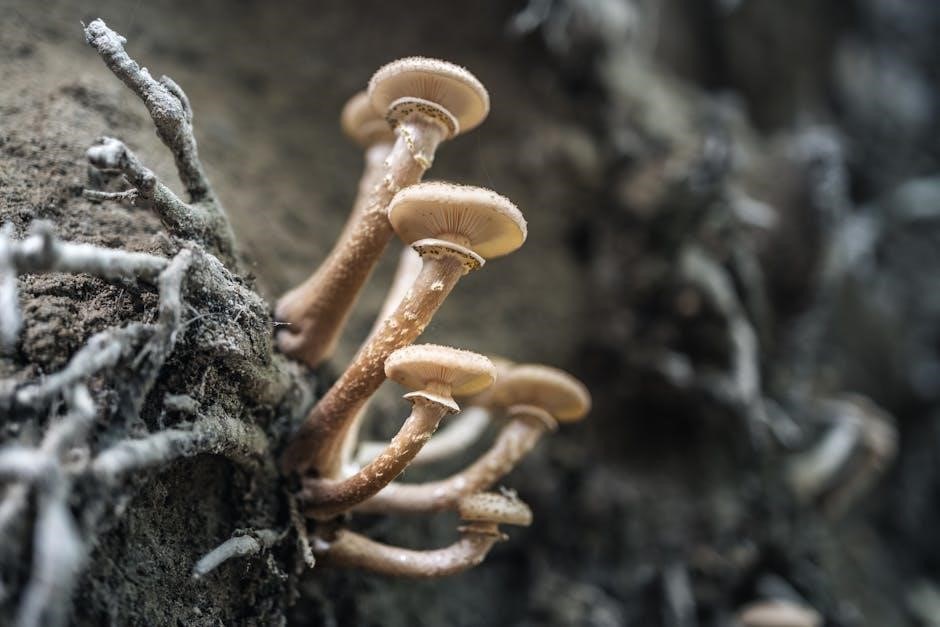
The Growing Process
The growing process involves preparing substrates, inoculating with spores, maintaining a sterile incubation environment, and monitoring humidity and temperature for optimal mushroom growth. Patience is key.
Equipment and Supplies Needed
To successfully grow psilocybin mushrooms, you’ll need specific equipment and supplies. Start with a clean growing container, such as a glass terrarium or grow bag, and a suitable substrate like brown rice flour mixed with vermiculite. Spores or a pre-made grow kit are essential for inoculation. Environmental control tools, such as a thermometer and hygrometer, are crucial for maintaining optimal temperature (70-80°F) and humidity (80-90%). A still air box or glove box is necessary for sterile inoculation. Sterilization supplies, like a pressure cooker or alcohol or a lighter, are vital to prevent contamination. Optional items include a humidity tent or air exchange system for fruiting. Additional supplies like a thermometer, hygrometer, and gloves are recommended. Using a pre-sterilized grow kit can simplify the process for beginners.
Preparing the Substrate
Preparing the substrate is a critical step in growing psilocybin mushrooms. Common substrates include brown rice flour, compost, or straw. Sterilization is essential to eliminate contaminants, typically done using a pressure cooker or autoclave. Once cooled, the substrate is mixed with water to achieve the right moisture level. Over-saturation should be avoided to prevent mold. The substrate is then stored in a clean environment until ready for inoculation. Proper preparation ensures a nutrient-rich base for mycelium growth, promoting healthy colonization and fruiting. A well-prepared substrate is the foundation for a successful grow, so attention to detail is crucial during this phase.
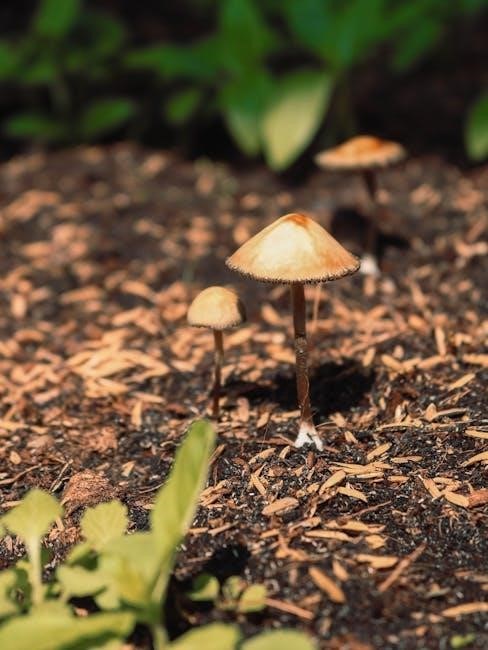
Inoculation and Spore Prints
Inoculation involves introducing psilocybin mushroom spores to the prepared substrate. Spore prints are created by placing a mature mushroom cap gill-side down on paper or glass, allowing spores to fall. These prints are used to inoculate substrates. For liquid cultures, spores are suspended in sterile water. Inoculation is typically done with a syringe, injecting spores into the substrate through pre-sterilized ports. Proper sterility is crucial to prevent contamination. Once inoculated, the substrate is sealed and transferred to an incubation environment. This step initiates mycelium growth, which colonizes the substrate over time. Successful inoculation requires precision, cleanliness, and patience to ensure healthy mycelium development.
Incubation Environment
The incubation environment is critical for mycelium colonization; Maintain a consistent temperature of 70-80°F (21-27°C) and high humidity, typically 80-90%. Use a sealed grow bag or humidity tent to retain moisture. Ensure complete darkness, as light can inhibit healthy mycelium growth. A clean, draft-free space is essential to prevent contamination. Monitor temperature with a thermometer and maintain humidity by misting lightly if needed. Avoid excessive moisture, which can lead to mold. The incubation period usually lasts 1-4 weeks, depending on the substrate and species. Proper conditions during this phase ensure robust mycelium development, setting the stage for successful mushroom growth.
Fruiting and Mushroom Growth
The fruiting phase begins once mycelium fully colonizes the substrate. Maintain high humidity (80-90%) and provide indirect light, such as 500-1000 lux, to trigger mushroom growth. Temperature should be slightly lower, around 65-75°F (18-24°C), to encourage pinning. Ensure proper airflow by opening the grow bag or tent slightly to exchange air. Pins will form within 1-2 weeks, maturing into mushrooms within 3-5 days. Monitor for contaminants and maintain a clean environment. Harvest mushrooms at the peak of their growth, typically when the caps open slightly. Consistent conditions are key for optimal fruiting and high-quality yields.
Hharvesting Techniques
Harvest mushrooms when the caps open slightly and the stem begins to separate from the cap. Use a clean knife or tweezers to gently twist and pull the mushroom from the substrate. Handle with care to avoid damaging the mycelium or nearby growth. Harvesting at the right time ensures maximum potency and minimizes contamination risk. For drying, place mushrooms on paper or a wire rack in a cool, dry, dark area. Avoid stacking to prevent moisture retention. Properly dried mushrooms can be stored for later use. Timing and technique are crucial for preserving quality and potency in your psilocybin mushroom crop.
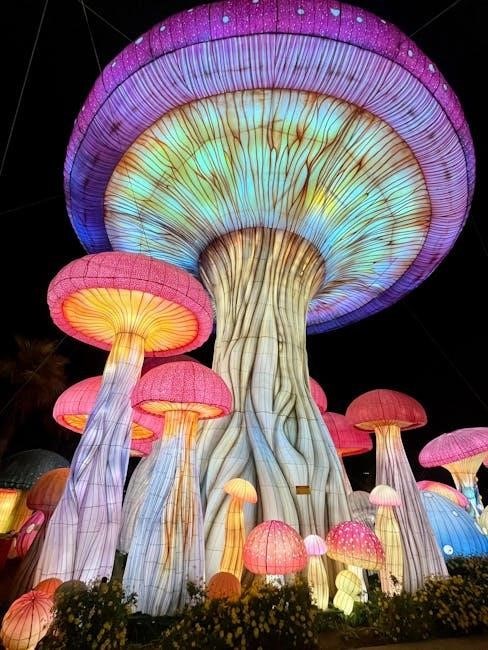
Optimizing Growth Conditions
Maintain consistent temperature (70-75°F), humidity (80-90%), and ensure proper airflow. Use thermometers, hygrometers, and humidity tents to monitor conditions, promoting healthy mycelium growth and fruiting.
Temperature Control
Maintaining the optimal temperature is critical for growing psilocybin mushrooms. The ideal range for mycelium growth is between 70-75°F (21-24°C), while fruiting typically occurs at 70-80°F (21-27°C). Sudden fluctuations can stress the mycelium, potentially stalling growth or encouraging contamination. Use a thermometer to monitor levels and ensure consistency. Heating mats or space heaters can help maintain warmth, while cooling methods like evaporative coolers or ice packs can lower temperatures if necessary. Avoid placing grow areas near drafts or extreme heat sources, as this can disrupt the controlled environment. Consistent temperature control is essential for healthy mycelium colonization and robust mushroom growth.
Humidity Management
Humidity management is vital for successful psilocybin mushroom cultivation. Maintain a relative humidity of 70-90% during colonization and fruiting phases. Use a hygrometer to monitor levels. Mist the substrate with sterile water daily to prevent drying out. Covering the grow area with a damp cloth or using a humidifier can help maintain consistent moisture. Avoid over-misting, as excessive humidity may lead to contamination. Ensure proper airflow to prevent moisture buildup. Balanced humidity supports healthy mycelium growth and promotes robust mushroom development. Regular monitoring and adjustments are essential to create an optimal environment for psilocybin mushrooms to thrive.
Lighting Requirements
Lighting is crucial for psilocybin mushroom growth, but they thrive in low-light conditions. Direct sunlight can inhibit growth, so indirect or diffused light is recommended. A north-facing window or shaded area provides ideal natural light. For artificial lighting, use low-intensity LED grow lights on a dim setting to avoid overexposure. Maintain a photoperiod of 8-12 hours of light daily to mimic natural cycles. Avoid prolonged darkness, as it can slow growth. Proper lighting supports healthy mycelium development and promotes even fruiting. Ensure consistent light levels to create an optimal environment for psilocybin mushrooms to grow successfully.
Airflow and Ventilation
Adequate airflow and ventilation are essential for healthy psilocybin mushroom growth. Proper air exchange prevents the buildup of carbon dioxide, which can inhibit mycelium activity and fruiting. Use fans or ensure a well-ventilated space to maintain consistent air circulation. Avoid sealing the growing area too tightly, as this can lead to stagnant conditions. Good airflow also helps regulate humidity levels, preventing moisture from accumulating and reducing the risk of contamination. Introduce fresh air gently to avoid shocking the delicate mycelium. Proper ventilation supports robust growth, ensures even fruiting, and maintains a healthy environment for your psilocybin mushrooms to thrive.

Troubleshooting Common Issues
Identify and address issues early to ensure healthy growth. Check for contamination, pests, or poor environmental conditions. Adjust temperature, humidity, or airflow as needed to resolve problems effectively.
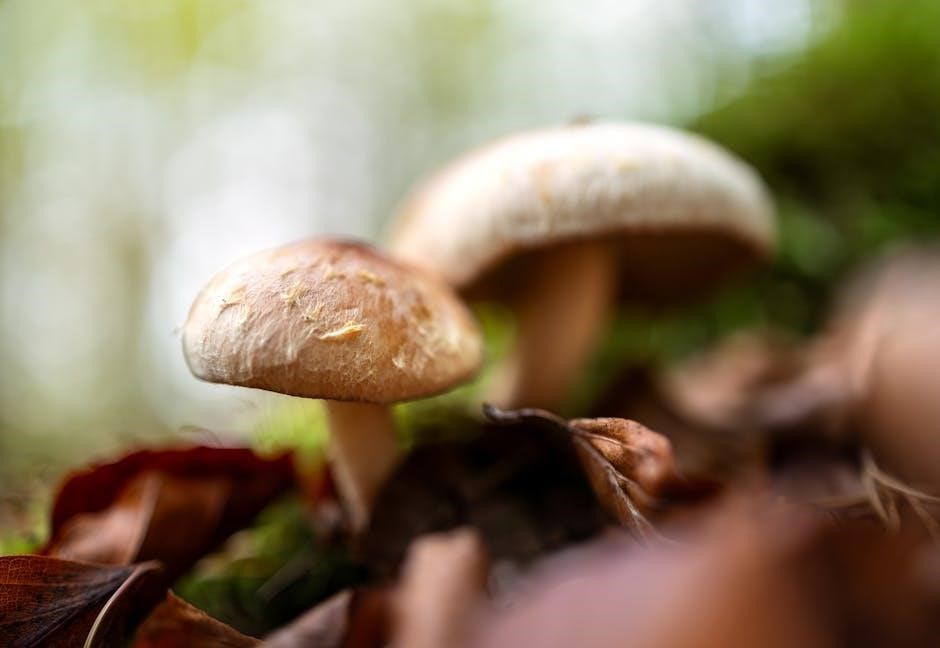
Contamination Prevention
Preventing contamination is crucial for successful psilocybin mushroom cultivation. Maintain a clean workspace and sterilize all equipment thoroughly. Use autoclaved substrates and handle spores in a sterile environment, such as a still air box. Wear gloves and ensure hands are clean before handling materials. Avoid cross-contamination by keeping supplies organized and separate; Regularly inspect for mold or bacteria growth, and address any issues promptly. Properly store spore prints and inoculation tools to minimize exposure to contaminants. A clean and controlled environment significantly reduces the risk of contamination, ensuring healthy mushroom growth and a successful harvest.
Dealing with Pests
Common pests like fungus gnats, mites, and springtails can threaten psilocybin mushroom cultivation. Regularly inspect the substrate and fruiting bodies for signs of infestation. Maintain a clean environment, sanitizing surfaces and tools to prevent pest attraction; Ensure proper humidity and airflow, as excessive moisture can attract pests. Introduce natural predators, such as predatory mites, to control infestations. Isolate infected batches to prevent the spread of pests. Avoid overwatering, as this creates ideal conditions for pests to thrive. Use non-toxic pesticides sparingly and only as a last resort. Early detection and prompt action are essential to protect your crop and ensure a healthy harvest.
Addressing Poor Growth
Poor growth in psilocybin mushrooms can result from inadequate light, incorrect temperatures, or insufficient humidity. Ensure the environment meets the species’ specific requirements, typically 70-85% humidity and 10-12 hours of indirect light. Check substrate quality and pasteurization processes, as contaminated or poorly prepared substrates hinder growth. Maintain consistent temperatures between 70-80°F during incubation. Overwatering or underwatering can also stunt growth; ensure proper moisture levels. Examine inoculation techniques, as improper methods may reduce mycelium colonization. Replace substrates or adjust environmental conditions if growth remains sluggish. Monitor for contamination and pests, addressing issues promptly to optimize mushroom development and yield.
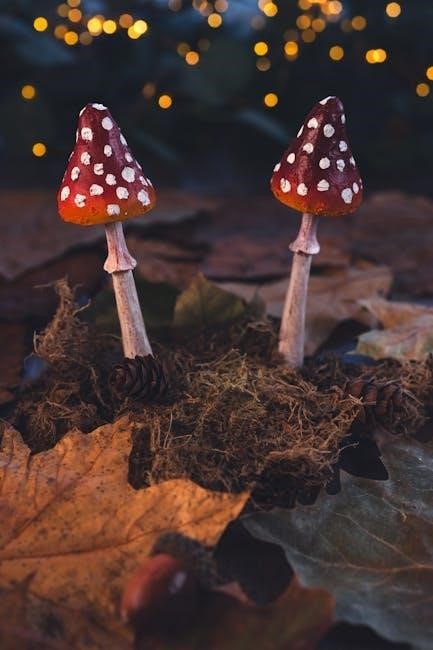
Advanced Growing Techniques
Explore outdoor cultivation, alternative substrates like straw or wood chips, and genetic strain selection to enhance yield and potency. These methods refine your growing expertise.
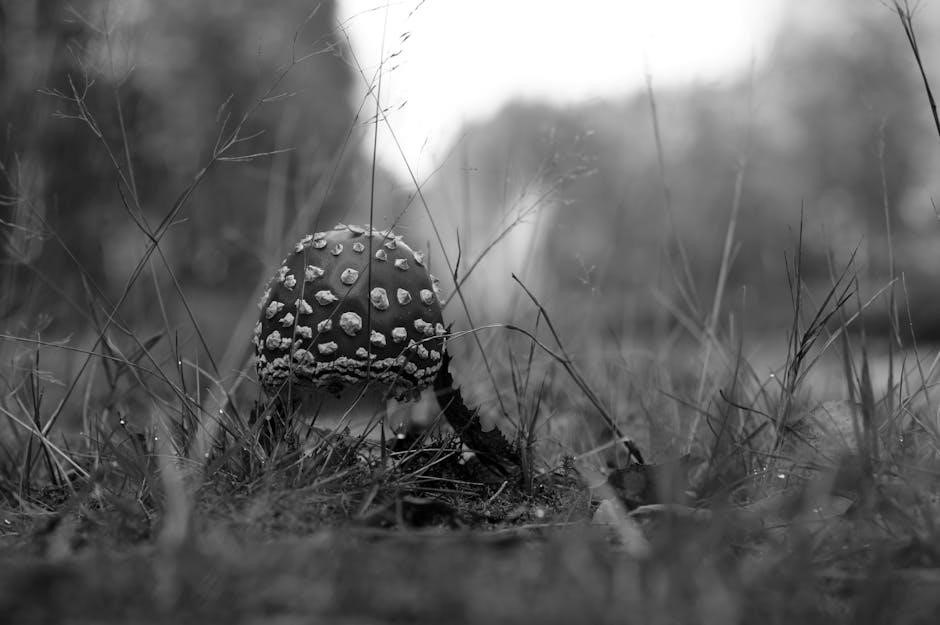
Outdoor Growing
Outdoor growing offers a natural environment for psilocybin mushrooms, leveraging sunlight and fresh air. Ideal conditions include shaded, moist areas with good airflow. Substrate preparation involves pasteurizing materials like wood chips or straw to eliminate contaminants. Inoculation with spore prints or plug spawn is done similarly to indoor methods, ensuring a clean environment to prevent contamination. Maintain consistent humidity, often achieved through mulching or misting. Monitor for pests and diseases, as outdoor settings pose higher risks. Proper substrate pH and nutrient balance are crucial. With careful planning, outdoor cultivation can enhance the natural growth patterns of psilocybin mushrooms, resulting in robust and healthy flushes.
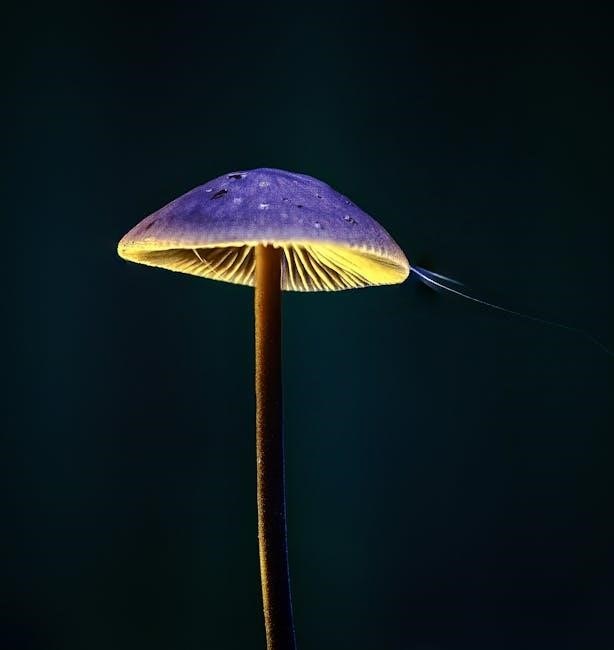
Using Different Substrates
Psilocybin mushrooms can be cultivated on various substrates, each offering unique benefits. Common substrates include straw, compost, wood chips, and grains like oats or rye. Straw is popular for its ease of use and high yield, while compost provides a nutrient-rich environment. Wood chips mimic the mushrooms’ natural habitat, promoting robust growth. Grains are ideal for sprinting or bulk substrates due to their high nutrient content. Proper preparation, such as pasteurization or sterilization, is essential to eliminate contaminants. The substrate choice depends on the grower’s preferences and resources, as each material supports different growth patterns and yields. Experimenting with substrates can enhance the overall cultivation experience and success.
Genetic Selection and Strains
Selecting the right genetic material is crucial for successful psilocybin mushroom cultivation. Different strains, such as B+, Golden Teacher, or Albino Penis Envy, offer varying growth patterns, potency, and fruiting characteristics. Genetics determine traits like yield size, colonization speed, and spore production. Growers can choose strains suited to their environment and desired outcomes. Spores are typically used for genetic selection, ensuring healthy and viable mycelium. Proper research and sourcing of spores from reputable suppliers are essential to avoid contamination and ensure consistency. Experimenting with multiple strains allows growers to identify which perform best under their specific conditions, optimizing both growth and results.
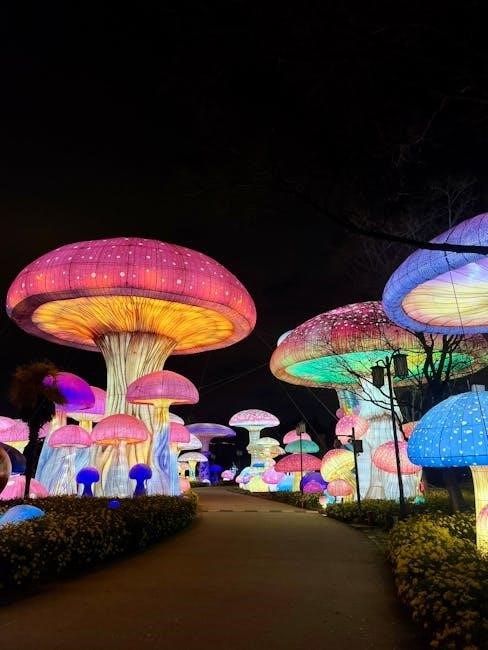
Legal and Ethical Considerations
Understand local laws regarding psilocybin mushrooms, as legality varies globally. Ensure responsible cultivation and use, adhering to ethical practices to avoid legal consequences and potential harm.
Understanding Local Laws
Psilocybin mushrooms are illegal under U.S. federal law, classified as a Schedule I controlled substance. However, some cities and states have decriminalized possession, such as Denver, Colorado, and Oregon, where personal use is no longer prioritized for prosecution. Laws vary globally, with countries like Jamaica and the Netherlands having more lenient policies. It is crucial to research and understand the legal framework in your region before considering cultivation or use. Penalties for illegal activities can include fines and imprisonment, making it essential to comply with local regulations to avoid legal consequences.
Responsible Cultivation Practices
Responsible cultivation of psilocybin mushrooms involves ethical and sustainable practices to ensure safety, environmental stewardship, and compliance with local laws. Growers should prioritize minimizing waste and using eco-friendly materials. Avoiding over-harvesting wild mushrooms is crucial to protect natural ecosystems. Ethical practices include sourcing spores and supplies from reputable vendors and ensuring fair trade. Transparency with individuals involved in the process, such as suppliers or buyers, is essential. Additionally, growers should adopt methods that reduce their carbon footprint, such as using renewable energy or sustainable substrates. By adhering to these principles, cultivators can contribute positively to both their community and the environment.
Cultivating psilocybin mushrooms is a journey requiring patience, knowledge, and responsibility. From spore to harvest, this guide equips growers with essential skills for a successful, ethical experience.
Cultivating psilocybin mushrooms requires attention to legal and safety considerations, proper substrate preparation, and precise environmental control. Inoculation and incubation are critical steps, followed by careful monitoring during the fruiting phase. Harvesting techniques and storage methods ensure maximum potency and longevity. Legal compliance and ethical practices are essential to avoid legal consequences and promote responsible use. Understanding local laws and adhering to guidelines ensure a safe and lawful growing experience. This guide provides a comprehensive approach to growing psilocybin mushrooms, emphasizing both practical techniques and ethical considerations.
Final Thoughts on Growing Psilocybin Mushrooms
Growing psilocybin mushrooms is a rewarding yet complex process that requires dedication, patience, and adherence to best practices. The journey from spores to mature mushrooms demands attention to detail, proper environmental control, and a commitment to safety. While the rewards can be significant, both for personal exploration and potential therapeutic benefits, it is crucial to approach cultivation with respect and responsibility. Always prioritize legal compliance, ethical practices, and mindfulness of the powerful effects these mushrooms can produce. By staying informed and thoughtful in your approach, you can navigate the challenges and enjoy the fruits of your labor responsibly and safely.
